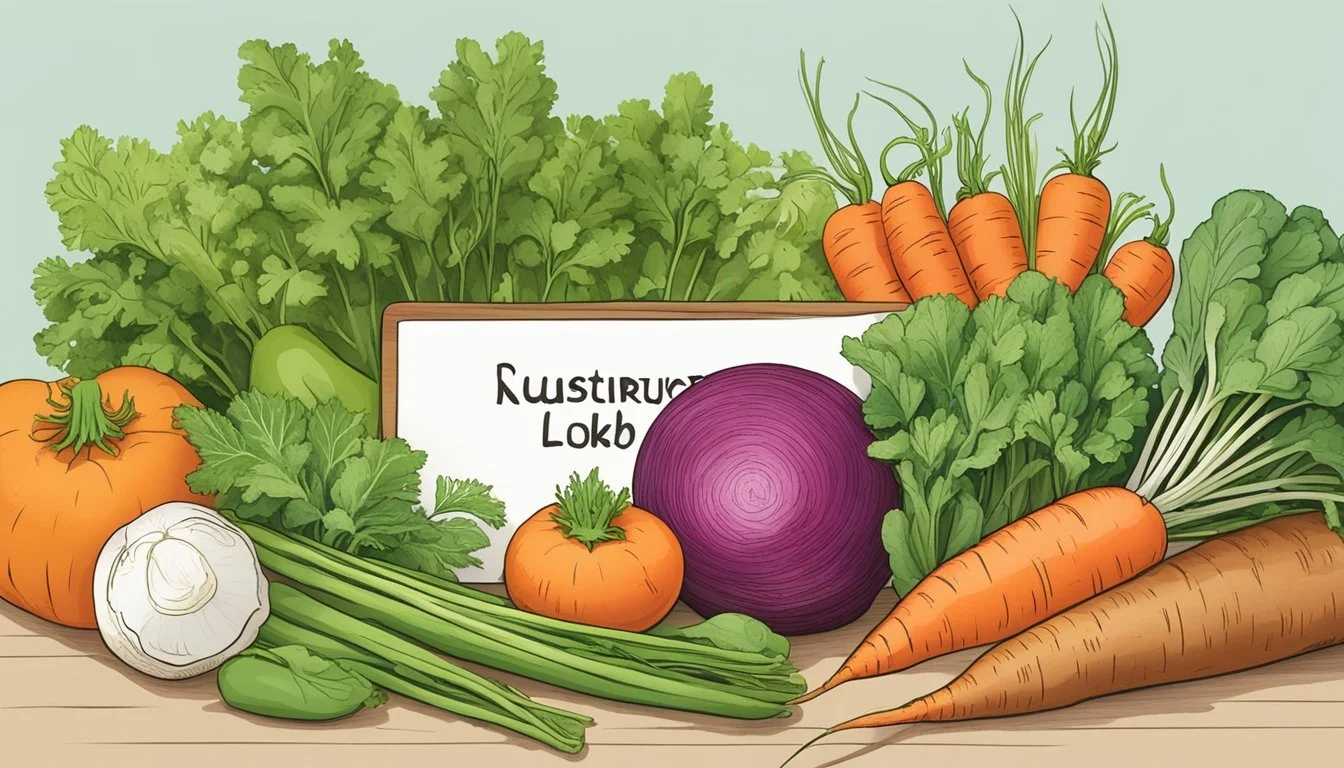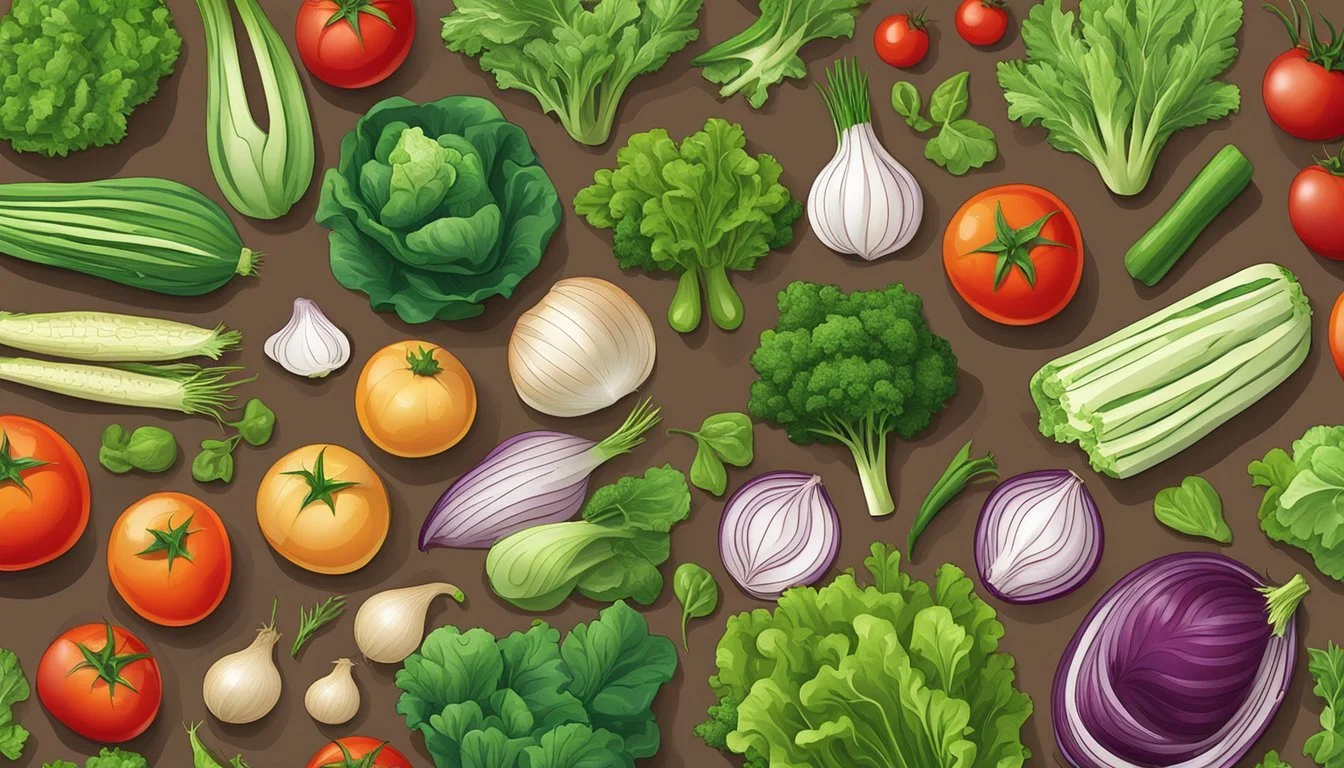Lobok Substitutes
Best Alternatives for Authentic Flavors
When you're preparing a dish that calls for lobok, also known as daikon radish, not having it on hand can be frustrating. Fortunately, there are several excellent substitutes available. One of the best substitutes for lobok is white radish, which shares a similar texture and mild flavor, making it perfect for salads and soups.
In addition to white radish, turnips offer a suitable alternative. They possess a subtle peppery taste and firm flesh comparable to lobok, making them versatile for both raw and cooked dishes. Parsnips, with their sweet and earthy notes, serve as another viable option, especially when roasted or used in stews.
Other viable substitutes include jicama and kohlrabi. Jicama provides a crisp, slightly sweet crunch ideal for salads. Kohlrabi, on the other hand, offers a hint of spiciness and is excellent either raw or cooked, adding a unique twist to your recipes. By knowing these alternatives, you can confidently continue cooking without missing a beat.
Understanding Lobok
Lobok is a traditional Indonesian condiment that is popular in Southeast Asia. This flavorful ingredient is often made using a combination of raw spices and seasonings that give it a distinctive taste.
Originating from Indonesia, Lobok is often seen in various national dishes. Its preparation varies, but it typically includes ingredients such as garlic, chili peppers, and sometimes shrimp paste.
Commonly used in dishes that require a spicy kick, Lobok enhances the flavor profile of many meals. It is especially prevalent in Asian cuisines where bold and robust flavors are celebrated.
Lobok can be hard to find in regions outside Indonesia, which has led to the need for substitutes. Some possible substitutes include sambal oelek, a chili-based sauce, or even sriracha for a milder alternative.
The versatility of Lobok makes it a beloved staple in many culinary traditions across Southeast Asia. Chefs and home cooks alike appreciate its ability to transform simple dishes into complex, flavorful experiences.
When looking for a substitute, it's essential to consider the fundamental characteristics of Lobok, such as its spice level and the depth of flavor contributed by raw ingredients. This ensures that the dish retains its intended taste.
Culinary Applications of Lobok
Lobok, also known as chili pepper, plays a vital role in adding heat and depth to various dishes. Its versatility allows it to be used both as a condiment and a key ingredient in cooking, enhancing flavors and providing a spicy kick.
As a Condiment
Lobok is frequently used as a condiment to accompany various foods. It is often blended into sambal, a popular Indonesian chili paste that combines garlic, spices, and sometimes vinegar and sugar. This spicy sauce pairs well with dishes like grilled meats, rice, and vegetables.
Another common use is the preparation of sambal oelek, a raw chili paste that highlights the pure, intense flavor of Lobok. Sambal oelek serves as a base for many sauces and marinades, adding a fiery punch to the mix.
Lobok is also pickled with vinegar and salt to produce a tangy and spicy relish. This condiment is perfect for topping noodles, rice dishes, and stir-fries, adding a zesty element that cuts through richer flavors.
In Cooking
In cooking, Lobok is a versatile ingredient that enhances a variety of dishes. It is a staple in soups and stews, where its flavor infuses well with other ingredients like garlic and spices. For instance, the Indonesian dish Bebalung uses Lobok to create a spicy, hearty broth with goat or cow ribs.
In stir-fries, Lobok adds heat and complexity, balancing the dish's sweet and savory elements. Marinades for meats and seafoods often include Lobok, either in its fresh form or as a paste, to impart a robust, spicy flavor.
Additionally, Lobok features prominently in spicy sauces served with grilled or fried foods. It can be cooked down with tomatoes and onions to create a rich accompaniment for proteins or vegetables. This chili's dynamic nature allows it to be a crucial component in many recipes, providing indispensable heat and depth.
Flavor Profile
Understanding the flavor profile of lobok is essential for finding the perfect substitute. Key elements include the basic taste components, the appropriate heat and spice levels, and enhancing tastes with other ingredients.
Key Flavor Elements
Lobok, also known as daikon radish, features a mild and slightly sweet flavor with a hint of pepperiness. Its sweetness comes from natural sugars, while the peppery note is akin to that found in radishes but less intense. The texture is crisp, especially when raw, adding a refreshing crunch to dishes. When cooked, lobok becomes tender and subtly sweet.
Key flavors to consider as substitutes:
Jicama: Mild sweetness with a similar crisp texture.
Turnips: Slightly bitter with a hint of spice.
Carrots: Known for their sweetness but different texture when cooked.
Heat and Spice
Lobok itself is not inherently spicy, but it pairs well with a variety of spices to boost its flavor. While considering substitutes, it's important to account for the desired heat level. Adding garlic can enhance the depth of the dish, and using cayenne, cumin, or spice blends such as sriracha can introduce a fiery heat.
Spices to consider:
Cumin: Earthy and warm, adding complexity.
Cayenne: For more assertive heat.
Sambal Oelek or Chili Paste: Provide both heat and texture.
Sriracha: Offers a balance of spice and sweetness.
Taste Enhancements
Enhancing the flavor of lobok substitutes often involves balancing salt, acid, and umami. Salt not only seasons but also brings out other flavors. Adding citrus juice like lemon or lime can inject brightness and sourness, complementing the mild flavors of the lobok or its substitutes. For umami, consider incorporating ingredients like soy sauce or miso.
Ways to enhance taste:
Salt: Essential for seasoning.
Citrus Juice: Adds acidity and freshness.
Soy Sauce or Miso: Brings umami depth.
By understanding these elements, you can effectively adjust flavors when substituting lobok in your recipes.
Common Substitutes
When certain ingredients are unavailable or out of stock, there are numerous substitutes that can be used to achieve similar flavors and textures in cooking. This section focuses on specific alternatives for pastes, sauces, and dry spices to ensure your dishes remain delicious and well-seasoned.
Paste Alternatives
For those looking to replace harissa or gochujang, consider using Thai chili paste or chili garlic sauce. These can mimic the spicy and savory notes, depending on the dish. Tomato paste is another versatile substitute; when mixed with a small amount of chili powder or flakes, it can serve as a base for various sauces.
Sambal oelek, a staple in many Asian recipes, can be substituted with a mix of crushed red pepper flakes and a touch of soy sauce for the umami flavor.
When substituting, the key is to balance the spice level and flavor complexity to match the original ingredient as closely as possible.
Sauce and Condiment Substitutes
Replacing sauces like Sriracha and Tabasco can be straightforward. Hot sauce or even a homemade mixture of garlic, vinegar, and hot peppers can serve as a quick fix. Ketchup mixed with a bit of cayenne pepper can also create a makeshift Sriracha.
For mayo replacements, olive oil or even a mixture of yogurt and a dash of mustard can provide a creamy texture and tangy flavor.
Soy sauce can be substituted with fish sauce or a homemade blend of soy sauce and a bit of brown sugar to replicate the sweet-salty balance.
Homemade Mixtures
Creating substitutes at home can often be more gratifying. For a homemade Sambal Oelek, blend fresh red chilies, vinegar, and a pinch of sugar. This mixture will provide the same spicy kick, with freshness from the chilies.
Mixing common pantry items can yield great results. Combining olive oil and garlic creates a simple yet flavorful base for many dishes. Another homemade mixture could involve black bean paste and honey to replace complex Asian sauces.
Chili crisp, a popular condiment, can be emulated by frying garlic, chili flakes, and shallots in oil until crispy, then combining the mixture for a crunchy, spicy topping.
Dry Spice Substitutes
Cayenne pepper can be substituted with red pepper flakes or even ground paprika for a less intense heat. For those seeking to replace caraway, fennel seeds or anise seeds can mimic the licorice-like flavor.
When it comes to spices like cumin or coriander, a blend of ground cloves and paprika can replace cumin, while cilantro seeds can stand in for coriander.
Creating your own dry spice blends is also an option. Mixing garlic powder, onion powder, and chili powder can produce a versatile seasoning that works for various culinary styles and preferences.
Substitute Preparation Techniques
When preparing substitutes in cooking, it's often essential to achieve the right consistency and flavor. This can be done through various techniques such as creating pastes and purees or blending herbs and spices.
Creating Pastes and Purees
One effective method for preparing substitute ingredients is using pastes and purees. These can be made using a food processor, blender, or even a mortar and pestle.
Homemade pastes often yield fresher flavors compared to store-bought versions. For a thicker consistency, it's important to control the liquid content. For instance, reducing the amount of added water when blending can result in a more concentrated paste.
Purees can be used to replace bulkier ingredients in dishes. For example, pureeing vegetables like carrots or squash can serve as a thickening agent in soups and stews. This method is particularly advantageous for those looking to add a nutritious and robust flavor profile to their meals without using more calorically dense ingredients.
Blending Herbs and Spices
Blending fresh herbs and dry spices can significantly alter the taste and aroma of substitute ingredients, adding complexity and depth.
When using fresh herbs, it is advisable to chop them finely before blending to release more of their natural oils, which enhances flavor integration. A food processor or blender is ideal for making herb blends, but a mortar and pestle can also be used for smaller quantities to achieve a rustic texture.
For dry spices, grinding them fresh using a spice grinder or mortar and pestle can release more potent flavors. Whole spices tend to retain their flavor longer than pre-ground versions. Combining freshly ground spices with pastes or purees can create a more vibrant and aromatic substitute.
In both cases, experimenting with ratios and combinations helps identify the best flavor profiles suitable for the dish being prepared. For instance, creating a homemade curry paste with a mix of garlic, ginger, fresh cilantro, and ground cumin can offer a dynamic alternative to premade options.
Considerations for Substitutions
When considering substitutes for Lobok, it is crucial to match characteristics such as flavor, texture, and nutritional values. This ensures the final dish remains true to its intended taste and quality.
Flavor Matching
One of the key factors in choosing a Lobok substitute is matching its mild, earthy flavor. Daikon radish is an excellent replacement as it shares a similar subtle taste, making it ideal for salads and soups. Jicama and turnips can also serve as substitutes, although they introduce slightly sweeter undertones. When substituting, adjust seasonings like garlic and salt as needed to maintain balance. Including a dash of vinegar can help replicate the slight bitterness of Lobok.
Texture and Consistency
Lobok's crisp texture is a notable feature, especially in recipes where a fresh crunch is desired. Jicama offers a similar crunch and is slightly juicier, making it a suitable substitute in raw dishes. Turnips provide a firmer bite and can be used in cooked recipes needing a thicker consistency. It's crucial to chop these substitutes into uniform pieces to mirror Lobok’s characteristic texture, ensuring an even cooking process.
Nutritional Aspects
Lobok is low in calories and rich in vitamin C, making it a nutritious addition to meals. Substitutes like Daikon radish and jicama also offer low-calorie options while being high in fiber and vitamins. It's essential to consider these nutritional benefits when selecting substitutes, particularly for health-conscious recipes. Turnips contribute similar benefits but with slightly higher carbohydrate content. Adjust portions to maintain a balanced nutritional profile in the dish.
Regional Variants and Similar Condiments
Sambal is a popular condiment in various regions, particularly in Indonesia, Malaysia, and Thailand. The basic ingredients include raw hot red chile peppers and salt, pounded together to form a chunky, spoonable paste.
In Malaysia, sambal variants often incorporate additional ingredients like shrimp paste, lime juice, and sugar to create complex flavors.
Sambal Oelek, produced by brands like Huy Fong Foods, focuses on a pure chili taste without the additional ingredients found in more complex sambals. This version is widely available and can function as a versatile substitute for other chili pastes.
Another similar condiment is Gochujang, which originates from Korea. While it has a fermented, deep flavor that's different from the fresher profile of sambal, it can serve as an alternative for those looking to maintain heat in their dishes.
For those seeking a simpler, direct chili paste, Thai Sriracha, made by companies like Lee Kum Kee, is a good option. It contains ingredients similar to sambal and is easily found in most supermarkets.
Condiment Region Key Ingredients Sambal Indonesia, Malaysia Chili peppers, salt, various herbs and spices Sambal Oelek USA (Huy Fong Foods) Chili peppers, salt, vinegar Gochujang Korea Chili powder, glutinous rice, fermented soybeans Sriracha Thailand (Lee Kum Kee) Chili peppers, garlic, vinegar, sugar, salt
Pairings and Combinations
Finding the right companions for lobok enhances its flavor and texture, making your dishes more exciting and balanced. This section explores the best meat and seafood combinations, complementary vegetables, and condiment synergies to elevate your culinary creations.
Meat and Seafood Companions
Lobok pairs well with various meats and seafood, adding a crisp and slightly peppery contrast. Pork and beef work particularly well, especially in stir-fries and soups where the lobok can absorb the savory flavors from the meats. Chicken is another good match, often seen in brothy dishes.
In seafood, shrimp and crab are ideal choices. The sweetness of these shellfish complements the mild bitterness of lobok. Fish, such as cod or tilapia, provides a delicate balance when steamed or poached with lobok slices. Marinating meats in soy sauce, ginger, and garlic before cooking can enhance the flavors further.
Vegetable Complements
Lobok is versatile, pairing well with various vegetables. Asparagus and green beans bring a crunchy texture that harmonizes with lobok's crispness. Mushrooms offer an earthy depth, whether you choose shiitake, cremini, or button varieties.
Eggplant can be a surprising yet effective pairing; its soft, creamy texture contrasts well with lobok in stir-fried or roasted dishes. Incorporating these vegetables can create a rich, multi-textured dish that showcases lobok's unique characteristics.
Condiment Synergy
In terms of condiments, lobok benefits from both traditional and bold flavors. Mayonnaise provides a creamy counterpoint, making it a good match for salads. Ketchup offers a sweet and tangy element, suitable for dipping or as a component in sauces.
Salsa adds a fresh, zesty note that can enliven both raw and cooked lobok. Additionally, sauces like soy sauce, hoisin, and oyster sauce can enhance the umami flavors, making lobok a standout component in any dish.
Combining these condiments appropriately will ensure the lobok's natural flavors shine through, complementing the overall dish.
Substitute Storage and Shelf Life
Proper storage is key to maintaining the quality of Lobok substitutes. Different substitutes have varying shelf lives and storage needs.
Dry Substitutes:
Flours and powders can be kept in airtight containers.
Store in a cool, dry place.
Shelf life: Up to 1 year.
Liquid Substitutes:
Refrigerate after opening.
Use within 7-10 days.
Freezing is generally not recommended due to potential quality issues.
Fermented Substitutes:
Store in sterilized jars.
Refrigerate to preserve freshness.
Can last several months to years depending on the type.
Fruit Purees:
Keep unopened cans in a pantry.
Once opened, refrigerate.
Shelf life: Up to 5-7 years unopened; 5-7 days opened.
Ensuring proper storage not only extends shelf life but also maintains the flavor and texture. For optimum results, always check the manufacturer's guidelines on storage and use.
Enhancing Recipes with Substitutes
Substituting ingredients can elevate your cooking, offering healthier, more accessible, or simply diverse options. Classic dishes benefit from tweaks, while modern cuisine thrives on innovative ingredient swaps.
Modifying Classic Dishes
Classic recipes like beef stew, pasta carbonara, and chocolate chip cookies can all be modified with ingredient substitutions without losing their essence. For instance, replace beef bouillon with vegetable broth or soy sauce for depth and umami, ideal for vegetarian or vegan versions of beef stew.
In baking, consider swapping wheat flour with gluten-free options like almond flour or rice flour to accommodate dietary needs. This maintains the texture and flavor in recipes like cookies or cakes. Use ground flaxseed as a vegan substitute for eggs in pancakes, ensuring a similar binding effect.
These modifications maintain the beloved taste while catering to modern dietary preferences and restrictions.
Innovative Use in Modern Cuisine
Modern culinary spaces are playgrounds for imaginative use of substitutes, which create trendy and exciting recipes. Aquafaba, the liquid from canned chickpeas, can replace egg whites in meringues or mousses, making dishes suitable for vegans.
Similarly, half-and-half can be recreated by blending whole milk and melted butter, or mixing whole milk with heavy cream. This can enhance dishes like creamy soups and sauces, achieving a rich consistency without traditional dairy ingredients.
Utilizing ground coriander instead of fresh cilantro in salsas or salads introduces a different but equally vibrant flavor profile, broadening the scope of contemporary recipes.
These culinary innovations bring new life and versatility to modern dishes, making them accessible and intriguing.
Conclusion
Lobok can be replaced in a variety of dishes with multiple suitable substitutes.
Daikon radish is ideal due to its similar texture and mild flavor.
Parsnips offer a pleasant alternative, especially when roasted or added to stews.
Jicama provides a juicy crunch that can enhance salads and light dishes.
Proper selection depends on the specific recipe and desired flavor profile.
When choosing a substitute, consider the cooking method and the dish's overall taste.
Experimenting with different substitutes can lead to interesting culinary discoveries.










